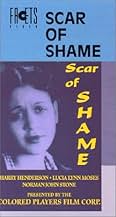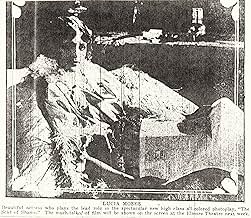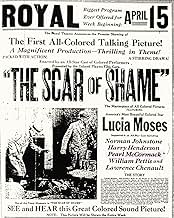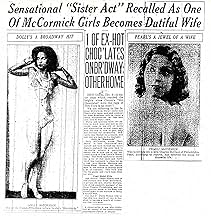AVALIAÇÃO DA IMDb
6,2/10
496
SUA AVALIAÇÃO
Adicionar um enredo no seu idiomaA black musician marries a woman facing abuse from her stepfather to rescue her. After the marriage, he refuses to introduce her to his mother, fearing his mother's disapproval of her lower ... Ler tudoA black musician marries a woman facing abuse from her stepfather to rescue her. After the marriage, he refuses to introduce her to his mother, fearing his mother's disapproval of her lower socioeconomic status.A black musician marries a woman facing abuse from her stepfather to rescue her. After the marriage, he refuses to introduce her to his mother, fearing his mother's disapproval of her lower socioeconomic status.
- Prêmios
- 1 indicação no total
Charles Gilpin
- Lido Club Gambler
- (não creditado)
Shingzie Howard
- Louise's Maid
- (não creditado)
Avaliações em destaque
Monday February 6, 7:00pm The Paramount Theater
In a contemporary study of film history The Scar of Shame (1927) has great value as an early surviving example of the "Race Movie" genre. These were motion pictures produced from the silent era through the nineteen-forties using black actors for a black audience in a racially segregated market. Race movies were screened in the schools and churches of small towns as well as theaters in larger cities. The films of Oscar Micheaux were of particular significance in the early days of the genre. "The Scar of Shame" was one of four films produced by The Colored Film Players Corporation of Philadelphia. Harry Henderson (Alvin Hillyard) is a well-educated musician with high aspirations. In an act of altruism he marries Louise Howard (Lucia Lynn Moses) to save her from her abusive Stepfather but is ashamed to take her home to his Mother because she not "in our set". Essentially a well executed melodrama, "The Scar of Shame " is noteworthy for its high production values which indicate a larger than typical budget, as well as elements of colorism and classism.
In a contemporary study of film history The Scar of Shame (1927) has great value as an early surviving example of the "Race Movie" genre. These were motion pictures produced from the silent era through the nineteen-forties using black actors for a black audience in a racially segregated market. Race movies were screened in the schools and churches of small towns as well as theaters in larger cities. The films of Oscar Micheaux were of particular significance in the early days of the genre. "The Scar of Shame" was one of four films produced by The Colored Film Players Corporation of Philadelphia. Harry Henderson (Alvin Hillyard) is a well-educated musician with high aspirations. In an act of altruism he marries Louise Howard (Lucia Lynn Moses) to save her from her abusive Stepfather but is ashamed to take her home to his Mother because she not "in our set". Essentially a well executed melodrama, "The Scar of Shame " is noteworthy for its high production values which indicate a larger than typical budget, as well as elements of colorism and classism.
7tavm
Since it's once again Black History Month, I thought I'd once again review various movies made by people of color for the occasion. This production of the Colored Players Film Corporation (which was co-founded by one African-American, Sherman H. Dudley, a former stage performer) was quite compelling as a cautionary drama though the melodramatic trappings do permeate. Still, there were quite some good performances by the cast of which one of them, a Lucia Lynn Moses, was quite alluring in going from a victimized girl to one trying to be more seductive. It's interesting finding out on this site she filmed this in Philadelphia while also commuting to New York as a chorus girl at the Cotton Club. I don't feel like revealing much else so on that note, I recommend The Scar of Shame.
An effective tragedy that demonstrates the importance of environment in shaping the lives of people.
I enjoyed this race movie intended for black audiences, even though I am not African-American or any racial minority. The forward states its point of view that a poor environment for a child will inevitably bring on a sense of shame, and then proceeds to unfold its story of an educated man in the field of music marrying a lower class woman to protect her from her stepfather, who beats her. Problems arise, however, when he won't take her to see his mother, who doesn't know he got married, and who he knows will be disappointed he did not marry a girl from his own class. My only problem with the movie was in the casting of the very refined Lucia Lynn Moses as the woman, so I could not fathom why her husband, well played by Harry Henderson, would not want his mother to meet her. It's an old-fashioned movie with some old-fashioned ideas, but has a few twists and wound up producing a few tears in my eyes. Watch it with some hankies close by if you are a softy for such movies, like me.
Too many who write reviews here do not understand how those in this film would have lived. The acting is strong, the sets are extraordinary, and the cinematography is exquisite! I loved the depth of character development, including the use of props to draw us closer to the characters and villains with actual heart! I want to see movies where we see more than one side to a villain, more than one side to a character, and more than side to a heroine, including something ugly at times. The heroine in this movie is deep with heart but with some vicious envy, loathingC anger, hatred, and ugliness. She is also sad, beautiful, hurt, and a victim. She needs protection.
There is no true hero here, i belive. This makes this movie truly interesting.
There is no true hero here, i belive. This makes this movie truly interesting.
Having finished reviewing Oscar Micheaux's three silent films that remain accessible to this day ("Within Our Gates," "The Symbol of the Unconquered" (both 1920) and "Body and Soul" (1925)), it was interesting to check out a race film made by others, "The Scar of Shame." While produced and directed by Jewish émigré filmmakers, although perhaps with an integrated crew, it features, in contrast to Micheaux's non-segregated oeuvre, an all-black cast from Colored Players Film Corporation of Philadelphia, with which they made four films, the last of which was this one. Those familiar with Micheaux's films will recognize among the supporting cast former Micheaux regular Lawrence Chenault, who starred in "The Symbol of the Unconquered" and "Body and Soul."
Like Micheaux's films, "The Scar of Shame" is a melodrama, but its singular focus on "uplift" to the exclusion of even the mention of race is in stark contrast to the African-American director's work. Being produced a few years later (sources differ on whether this one is from 1927 or 1929) and evidently with more financing and resources than Micheaux's surviving silents, "The Scar of Shame" does feature superior production values. Improvements in lighting, or the luxury of retakes and censors not ripping the nitrate to shreds, though, are at the expense of sophisticated storytelling, intriguingly complex plotting, greater relevance and an ideology that challenges rather than muddles. For all the technical limitations, I'll take a Micheaux silent over the glitz and classist commentary on class, or "caste," as its titles often put it, of "The Scar of Shame" any day.
That's not to say this film doesn't have more than superficial appeal. Just as a historical record and a glimpse into the depiction of class distinctions in black communities from the 1920s is interesting. Moreover, once the picture picks up, the melodramatics are sometimes amusingly unpredictable until the aggravating conclusion. I hate these old-timey melodrama contrivances that always sacrifice the poor woman (and always a woman, usually of lower class, and often marked by some physical deformity) to make way for a supposedly-happy resolution for the upper-class couple. The same thing annoys me when it happens in, say, a Mary Pickford vehicle such as "Stella Maris" (1918). Micheaux's silents, by contrast, are also remarkable for how advanced they are in the representation of sex, including female protagonists and heroines who rescued the men. You won't find that here. The hero rushes to rescue the damsel-in-distress three times, including once from little more than saving her from accepting a job, I guess. And a woman's scar, which is easily concealed with scarves, is described at one point as completely marring her beauty.
Additionally, if you thought Micheaux was overly didactic, try the hero here practically talking directly to the camera from the get go about uplifting the poors with "the finer things in life," which seems to consist largely of playing piano, a bit of reading and not abusing women. All fine things, indeed, even if every time "finer things" are mentioned I was reminded of the Finer Things Club from "The Office" TV series. It doesn't help that the lead male character here is quite pompous. "Oh! Our people have much to learn!," he bemoans as the picture has long since moved past pictures of Frederick Douglass hanging on the walls to a close-up of a copy of a "True Romance" book, and as the picture's silence on race seems to do little more than support another, more illusory caste system. Talk about mixed messages.
Like Micheaux's films, "The Scar of Shame" is a melodrama, but its singular focus on "uplift" to the exclusion of even the mention of race is in stark contrast to the African-American director's work. Being produced a few years later (sources differ on whether this one is from 1927 or 1929) and evidently with more financing and resources than Micheaux's surviving silents, "The Scar of Shame" does feature superior production values. Improvements in lighting, or the luxury of retakes and censors not ripping the nitrate to shreds, though, are at the expense of sophisticated storytelling, intriguingly complex plotting, greater relevance and an ideology that challenges rather than muddles. For all the technical limitations, I'll take a Micheaux silent over the glitz and classist commentary on class, or "caste," as its titles often put it, of "The Scar of Shame" any day.
That's not to say this film doesn't have more than superficial appeal. Just as a historical record and a glimpse into the depiction of class distinctions in black communities from the 1920s is interesting. Moreover, once the picture picks up, the melodramatics are sometimes amusingly unpredictable until the aggravating conclusion. I hate these old-timey melodrama contrivances that always sacrifice the poor woman (and always a woman, usually of lower class, and often marked by some physical deformity) to make way for a supposedly-happy resolution for the upper-class couple. The same thing annoys me when it happens in, say, a Mary Pickford vehicle such as "Stella Maris" (1918). Micheaux's silents, by contrast, are also remarkable for how advanced they are in the representation of sex, including female protagonists and heroines who rescued the men. You won't find that here. The hero rushes to rescue the damsel-in-distress three times, including once from little more than saving her from accepting a job, I guess. And a woman's scar, which is easily concealed with scarves, is described at one point as completely marring her beauty.
Additionally, if you thought Micheaux was overly didactic, try the hero here practically talking directly to the camera from the get go about uplifting the poors with "the finer things in life," which seems to consist largely of playing piano, a bit of reading and not abusing women. All fine things, indeed, even if every time "finer things" are mentioned I was reminded of the Finer Things Club from "The Office" TV series. It doesn't help that the lead male character here is quite pompous. "Oh! Our people have much to learn!," he bemoans as the picture has long since moved past pictures of Frederick Douglass hanging on the walls to a close-up of a copy of a "True Romance" book, and as the picture's silence on race seems to do little more than support another, more illusory caste system. Talk about mixed messages.
Você sabia?
- CuriosidadesFilm scholar Donald Bogle called this movie quite possibly the best independent black film of the silent era.
- Erros de gravaçãoAfter Alvin leaves his mother's house, the butler reaches down to pick up the dropped key with his left hand, the next shot is a closeup of him picking up the key with his right hand. The next shot he is standing up with the key in his left hand.
- Citações
Title Card: One half the world doesn't know how the other half lives.
- Versões alternativasThe Library of Congress Video Collection has a restored version of this film with a new piano score composed and performed by Philip Carli. Its running time is 76 minutes. A small missing section is summarized by an intertitle. Other restoration credits: Simmon, Scott ....... restoration producer Fleming, Dina T. .... restoration production co-ordinator McConnell, Allan .... restoration magnetic recording laboratory head Winther, James ...... restoration videotape transfer and editor Chrisman, Paul ...... restoration music recordist DeAnna, Gene ........ restoration titles
- ConexõesFeatured in Experiência Americana: Midnight Ramble (1994)
Principais escolhas
Faça login para avaliar e ver a lista de recomendações personalizadas
Detalhes
- Tempo de duração
- 1 h 8 min(68 min)
- Cor
- Mixagem de som
- Proporção
- 1.33 : 1
Contribua para esta página
Sugerir uma alteração ou adicionar conteúdo ausente





